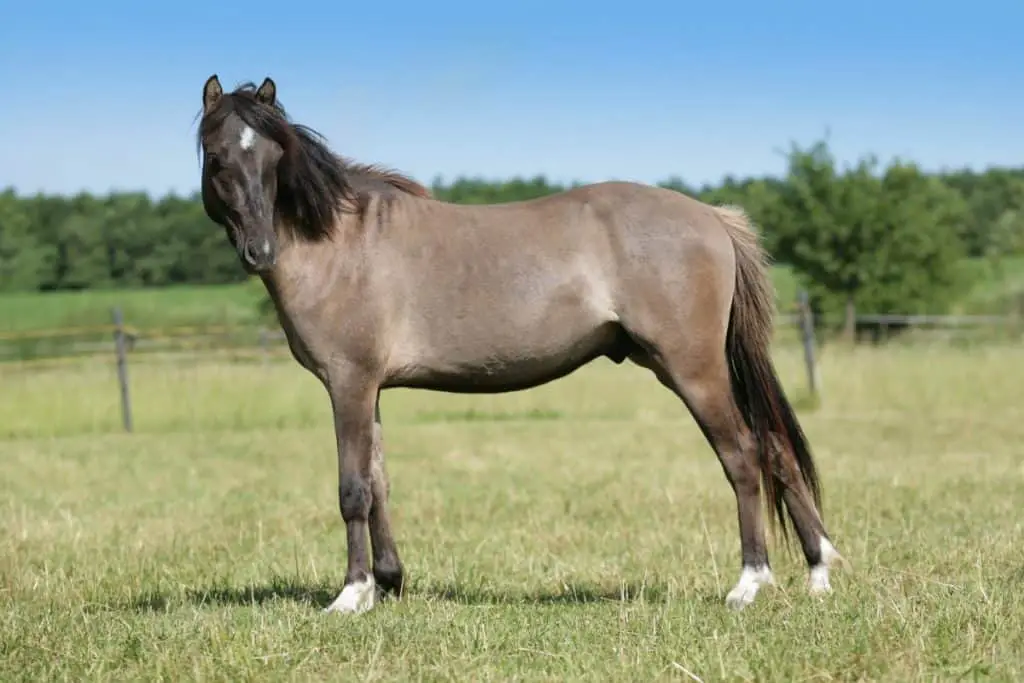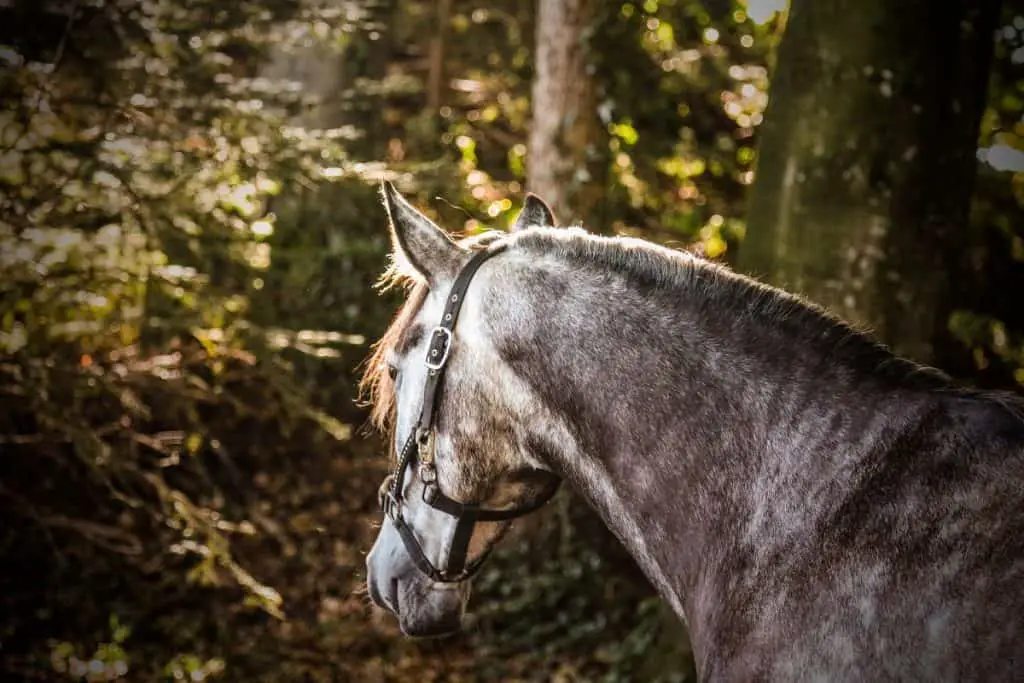Skip To Section
A male horse that has its testicles removed, that is, castrated, is called a gelding. The term is also used for other equines like donkey and mule. Castration causes sterilization, which prevents an animal from reproducing. It also significantly reduces the production of certain hormones, which allows the horse to be calmer and better-behaved. A gelding horse, thus, is much more suitable to be a working animal.
What Is The Recommended Age For Gelding A Horse?
Gelding can be done as soon as the testicles descend to the scrotum in a young horse. Thus, male horses, as young as one-year-old, may be gelded. You may, however, geld a horse at any age.
Many veterinarians also prefer castrating horses less than a year old as young colts have smaller testicles that are easier to remove. There are also lesser chances of bleeding and postoperative complications.
Many horse owners believe that the earlier you geld a male horse, the lesser it develops stallion-like behavior. Gelding reduces testosterone production, the hormone responsible for aggressive and dominant behavior in stallions. Testosterone also helps in developing stallion-like physical attributes like a crested neck. The gelding is also believed to make horses grow taller. Castration delays the closing of the growth plates in horses resulting in taller horses.
Aggressive behavior in stallions is considered dangerous for other horses, as well as anyone handling the horses. Since they are castrated, gelding horses show little or no interest in mares.

What Are The Differences Between Geldings And Stallions?
The most significant difference between geldings and stallions is that geldings are neutered while stallions are not. Thus, stallions are used for breeding purposes as they can reproduce with mares. A gelding is a castrated horse and hence cannot reproduce.
Geldings are calmer and tamer than stallions. Hence, they make excellent work animals, especially for riding. If you are new at horse riding, a gelding makes for a safer and wiser choice. Many riders prefer to choose geldings over stallions or mares because of this precise reason. While stallions are aggressive, mares can get moody, especially when in heat.
Geldings are more obedient and better-behaved than stallions. The reduced testosterone production makes them less aggressive and dominant. This means that geldings are better for working and stallions for breeding.
Stallions look for mares as they are sexually active, whereas geldings have little interest in them.
Geldings, typically, grow taller than stallions.
Can A Gelded Horse Still Breed?
Even though gelding reduces the sex drive in male horses, they can remain sexually active. They may not be as intense as stallions, but they may still try to mate with mares. However, since geldings have their testicles removed, they are unable to reproduce.
How Long After Gelding Are Horses Fertile?
A male foal can be fertile for a short while, even after castration. Veterinarians suggest not to turn out colts with mares for at least two months after gelding.
Is A Gelding Horse, A Boy Or A Girl?
Gelding horses are male horses that have been castrated, that is, have their testicles removed.
What Are The Benefits Of Equine Gelding?
Gelding horses has been prevalent for hundreds of years. In medieval times when wars were fought on horseback, geldings were preferred over stallions or mares. Geldings were used as war horses as they were easier to control, lacked the urge to mate, and were less likely to call out to other horses. They were also less likely to fight with each other and hence were easier to be kept in groups.
Gelding not just makes better-behaved animals, it also helps control the gene pool. By sterilizing inferior quality horses, only the finest stallions are left to breed. Experts believe that the percentage of stallions should be no more than 10% of the breeding stock. Among wild horses, the 10% ratio is naturally maintained as a single stallion acts as the leader of the herd. The stallion breeds with the herd, which typically contains about 10 to 12 mares.
Geldings, being easier to handle than stallions, are preferred in equestrian events. Stallions often need experienced riders, while geldings are good with both novices and experienced riders.
Geldings also have a distinct advantage over mares as they are less temperamental. Also, the use of mares during pregnancy is usually limited, especially during the later months.
In horse racing, gelding can be a suitable option for stallions who get easily distracted or are tough to handle. Though the gelding cannot produce offsprings, it can definitely boost the reputation of the stallion that fathered the gelding.
Though gelding is mostly performed on young colts, stallions may also be gelded later in life. If the offsprings that the stallion sires are of inferior quality, then the stallion may be sterilized.
Gelding horses is an approved means to maintain population control among horses. It allows more horses to live together safely and in the proximity of humans and other animals.
What Are The Castration Techniques Used In Gelding Horses?
There are two major castration techniques used in gelding a horse. They are:
1. Standing Castration
In the standing castration process, the horse is sedated and local anesthesia is given. The horse is not completely knocked out or put to the ground. However, the horse is physically restrained during this procedure.
The veterinarian injects the local anesthesia into the testes, and they are then removed through an incision in the scrotum. The spermatic cord is also ligated off. Once the testicles are removed, the veterinarian carefully checks for any signs of bleeding. The horse, now a gelding, is then allowed time to recover.
It is difficult to perform standing castration on miniature horses. The horse must be big enough for the veterinarian to lean under the belly to remove the testicles.
Even though the horse may be restrained, there are high chances that it does not like the procedure and may kick the veterinarian performing the procedure.
2. Recumbent Castration
Recumbent castration is the process of putting a horse under general anesthesia. Most veterinarians prefer this surgical procedure as it poses a lesser risk for the horse as well as the veterinarian. Since the horse is rendered unconscious, there are no chances of injury to the veterinarian.
Other advantages of this procedure are that a sterile environment can be maintained, and the horse is in a prone position. It also minimizes the chances of bleeding after the testes are removed.
However, general anesthesia may have its own set of complications. Hence, veterinarians have to take great care while performing this procedure.
How To Care For Your Horse After Gelding
Gelding has been performed on horses for centuries. Even though it may seem like a simple surgical procedure, there may be complications. Hence, it is important to care for your horse after the gelding procedure to help it recover well.
You should allow the horse to rest quietly for at least 24 hours after the surgery.
You must ensure to keep the incision area clean to prevent the chances of infection. You must also give the horse antibiotics as prescribed by your veterinarian.
It is also important to allow your horse some light exercise to quicken the recovery process. Exercise helps the incision drain properly, thereby fastening the recovery of the horse.
Make sure the incision site has no swelling and keep flies away from your horse.
The change in “behavior” may take anywhere between 6 to 8 weeks. It is best not to let them out with mares or other horses during this time to minimize the chances of injury.

Why Does My Gelding Still Act Like A Stallion?
There are two possibilities if your gelding still acts like a stallion:
- Your horse may have a cryptorchid testicle. It is when one or both of the testicles have not descended properly. A testicle may be retained in the abdomen or high in the flank, which is still releasing testosterone. Testosterone production can cause stallion-like behavior in your gelding.
- Your horse may be a gelding, yet display stallion-like behavior as it has learned it that way. Young horses learn from other horses, and that’s exactly what your gelding is doing. With correct training, you may be able to resolve most of these behavioral issues.
Will Gelding Affect The Performance Of My Horse?
Most people worry that gelding may affect their horse’s performance or development. However, that is not true.
Gelding horses tend to be taller than stallions making them more suitable for competitions. They are also easier to maintain and hence are more cost-effective than stallions.
Gelding horses behave like normal horses, just with a decreased desire to breed. They do not lose their edge, can perform equally well, but they are carefree.
Conclusion
Whether you own a gelding or a stallion, owning a horse can be an incredible experience. Horses have a stellar reputation; after all, they did win many wars in history. Owning a horse is not just impressive but also displays your adventurous side. Horseback riding can be both fun and therapeutic at the same time.

